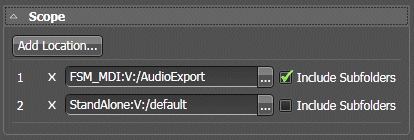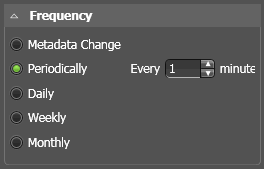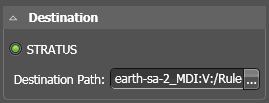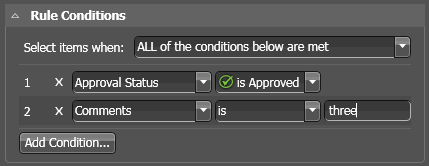Adding an archive rule
The GV STRATUS
Rules Engine can watch a location that is in the GV STRATUS system and transfer assets that match your criteria to an
archive location. An archive rule can export clips, subclips, and
playlists. For playlists, a conform job is automatically triggered to render the
complex asset as a simple clip. The Rules Engine transfers the assets to the
destination that you configure. If an asset already exists at the archive
destination location, the Rules Engine appends a suffix to the asset file name so
that the transfer can succeed without overwriting the existing asset.
- Log in to the GV STRATUS Control Panel application with administrator privileges.
- In the GV STRATUS Control Panel application, click General | Rules.
- Click Add. Rules Editor settings open.
- In the Rule Type drop-down list select Archive.
- In the Name field type in a name for the rule you are configuring.
- In the Description field type in a description for the rule you are configuring.
-
In Rule Options settings,
specify the rule behavior.
- Select whether the rule copies or moves the asset. If you select move, after the rule transfers the asset, it removes the source asset from the GV STRATUS system.
-
Select when the rule is applied each
asset.
- Execute rule only once per asset: The rule is applied once per asset. The Rules Engine uses data stored in the asset's ExecutedByRules metadata field to determine if the rule has been applied to the asset. If it has been applied, the Rules Engine does not apply it again, even if the rule criteria still match for the asset.
- Execute every time rule conditions apply: The rule can be applied multiple times per asset, if the asset matches rule conditions multiple times.
-
Select the priority that the Rules
Engine processes the rule, with the transfers and transcodes the
rule controls, when there are multiple rules in a queue waiting to
be processed.
- Priority: High: Put this rule in a queue with other high priority rules and process through the high priority rule queue before any normal priority or low priority rules.
- Priority: Normal: Put this rule in a queue with other normal priority rules and process through the normal priority rule queue after any high priority but before any low priority rules.
- Priority: Low: Put this rule in a queue with other low priority rules and process through the low priority rule queue after any high priority or medium priority rules.
-
In Scope settings, specify the
location or locations in which the rule operates.
For archive rules, only valid K2
system locations are available.
- Click Add location. The Location Selection dialog box opens.
- Navigate to and select the desired location. This is the location that contains the files on which the rule operates. Every time the rule runs, it looks in this location to determine if there are any assets that match the rule conditions and then operates on the assets that match.
- Click OK. The location is added to the Scope list.
- For a location in the list, if you want the rule to operate on sub-folders as well, select Include Subfolders. When this is selected, if there are multiple directories under the selected location, the rule operates in each of the sub-directories.
- Repeat these steps to add additional locations as desired.
-
To change a location in the list,
click the
Browse button

- To remove a location from the list, click X.
-
In Frequency settings, specify how often the Rules Engine
triggers the rule.
-
Select one of the following
options:
- Metadata Change: The rule is constantly monitoring assets in the "Scope" location.
- Periodically: Sets the number of minutes.
- Daily: Sets the number of days.
- Weekly: Sets the number of weeks.
- Monthly: Sets the day of each month.
-
Select one of the following
options:
- In Destination settings, specify the destination of the assets on which the rule operates. For archive rules, only valid archive locations are available.
-
For Destination Path, click the
Browse button
 .
The Select Destination Path dialog
box opens.
.
The Select Destination Path dialog
box opens.
- Navigate to the desired location and click OK.
- In Rule Conditions settings, specify the conditions the Rules Engine looks for to qualify an asset.
-
In the Select items
when drop down list, select one of the following:
- ALL of the conditions below are met: Assets that match all conditions.
- ANY of the conditions below are met: Assets that match any condition.
- Custom: A Custom Expression field opens in which you can enter a custom expression.
-
Configure conditions as
follows:
- For each condition (1, 2, 3, 4, etc) click the Add Condition button and select from lists to define the condition.
- Click the X button to remove a condition from the list.
If the rule applies to newly created assets, such as those created by a scheduled record, configure Duration | is greater than | 00:00:00.00. This ensures the asset is ready to transfer.
If a newly created custom metadata field is not available in the Add Condition dialog, restart the GV STRATUS Control Panel application.
- Click Save.





